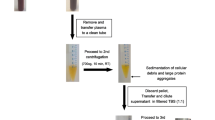Abstract
A novel method for in vivo evaluation of cell death in patients with acute and/or chronic heart diseases, accompanied by apoptosis or cell necrosis has been developed. The method is based on the analysis of cell free DNA (cfDNA) in the blood serum (plasma). It includes estimation of concentration of serum ribosomal repeat (rDNA), content of rDNA in total cfDNA, as well as factors of cfDNA elimination, such as nuclease activity and anti-DNA antibody. We have found a fivefold increase in serum cfDNA concentration and a 12-fold increase of serum rDNA concentration in patients with acute myocardial infarction compared with healthy individuals. In chronic coronary ischemia serum cfDNA concentration was nearly normal, but the content of rDNA in cfDNA was 4.8-fold higher, and the serum rDNA concentration was increased sevenfold. We hypothesize that putative reason for accumulation of rDNA within cfDNA might be attributed to the previously reported resistance of rDNA to the ds-fragmentation by serum endonucleases. In acute and chronic coronary disease serum nuclease activity and the titer of anti-DNA antibodies (which are mainly bound to the cfDNA) was substantially higher than in the healthy controls. It is suggested that release of rDNA fragments into blood not only reflects cellular death in the body but also determines the response of the organism to the disease-associated stress.
Similar content being viewed by others
References
Vlassov, V.V., Laktionov, P.P., and Rykova, E.Y., Bioessays, 2007, vol. 29, pp. 654–667.
Antonatos, D., Patsilinakos, S., Spanodimos, S., Korkonikitas, P., and Tsigas, D., Ann. N.Y. Acad. Sci., 2006, vol. 1075, pp. 278–281.
Kawai, Y., Yoshida, M., Arakawa, K., Kumamoto, T., Morikawa, N., Masamura, K., Tada, H., Ito, S., Hoshizaki, H., Oshima, S., Taniguchi, K., Terasawa, H., Miyamori, I., Kishi, K., and Yasuda, T., Circulation, 2004, vol. 109, pp. 2398–2400.
Veiko, N.N., Kostyuk, S.V., Ermakov, A.V., Kalashnikova, E.A., Ryazantseva, T.A., and Speranskii, A.I., Byull. Eksper. Biol. Med., 2007, vol. 144, pp. 277–282.
Veiko, N.N. and Spitkovskii, D.M., Radiatsionnaya Biologiya. Radioekologiya, 2000, vol. 40, pp. 396–404.
Veiko, N.N., Shubaeva, N.O., Ivanova, S.M., Speranskii, A.I., Lyapunova, N.A., and Spitkovskii, D.M., Byull. Eksper. Biol. Med., 2006, vol. 143, pp. 282–285.
Veiko, N.N., Egolina, N.A., Radzivil, G.G., Nurbaev, S.D., Kosyakova, N.V., Shubaeva, N.O., and Lyapunova, N.A., Mol. Biol., 2003, vol. 37, pp. 409–419.
Veiko, N.N., Lyapunova, N.A., Bogush, A.I., Tsvetkova, T.G., and Gromova, E.V., Mol. Biol., 1996, vol. 30, pp. 1076–1084.
Ermakov, A.V., Kostyuk, S.V., Egolina, N.A., Malinovskaya, E.M., and Veiko, N.N., Radioatsionnaya Biologiya. Radioekologiya, 2007, vol. 47, pp. 133–140.
Pisetsky, D.S. and Gonzalez, T.C., clin. Exp. Immunol., 1999, vol. 116, pp 354–359.
Vernon, S.D., Shukla, S.K., Conradt, J., Unger, E.R., and Reeves, W.C., BMC Microbiol., 2002, vol. 2, pp. 2–39.
Stroun, M., Lyautey, J., Lederrey, C., Mulcahy, H.E., and Anker, P., Ann. N.Y. Acad. Sci., 2001, vol. 945, pp. 258–264.
Yasutomo, K., Horiuchi, T., Kagami, S., Tsukamoto, H., Hashimura, C., Urushihara M., and Kuroda, Y., Nat. Genet., 2001, vol. 28, pp. 313–314.
Napirei, M., Karsunky, H., Zevnik, B., Stephan, H., Mannherz, H.G., and Möröy, T., Nat. Genet., 2000, vol. 25, pp. 135–136.
Kostyuk, S.V., Fragmenty ribosomnykh genov v sostave vnekletochnoi DNK-factory stress-signalizatsii, Cand. Sci. Dissertation: Research Center for Medical Genetics RAMS, Moscow, 2007.
Kyung, Y., Tuetken, R., Redford, T., MaWaldschmidt, R., Kirsch, J., and Krieg, A.M., J. Immunol., 1998, vol. 160, pp. 4755–4761.
Klinman, D.M., Yi, A.K., Beaucage, S.L., Conover, J., and Krieg, A.M., Proc. Natl. Acad. Sci. USA, 1996, vol. 93, pp. 879–883.
Veiko, N.N., Kalashnikova, E.A., Kokarovtseva, S.N., Kostuk, S.V., Ermakov, A.V., Ivanova, S.M., Ryazantseva, T.A., Egolina, N.A., Lyapunova, N.A., and Spitkovskii, D.M., Byull. Eksper. Biol. Med., 2006, vol. 143, pp. 410–414.
Author information
Authors and Affiliations
Corresponding author
Additional information
Original Russian Text © N.N. Veiko, N.A. Bulycheva, O.A. Roginko, R.V. Veiko, E.S. Ershova, O.A. Kozdoba, V.A. Kuzmin, A.M. Vinogradov, A.A. Yudin, A.I. Speranskyi, 2008, published in Biomeditsinskaya Khimiya.
Rights and permissions
About this article
Cite this article
Veiko, N.N., Bulycheva, N.A., Roginko, O.A. et al. Ribosomal repeat in cell free DNA as a marker for cell death. Biochem. Moscow Suppl. Ser. B 2, 198–207 (2008). https://doi.org/10.1134/S1990750808020121
Received:
Published:
Issue Date:
DOI: https://doi.org/10.1134/S1990750808020121




